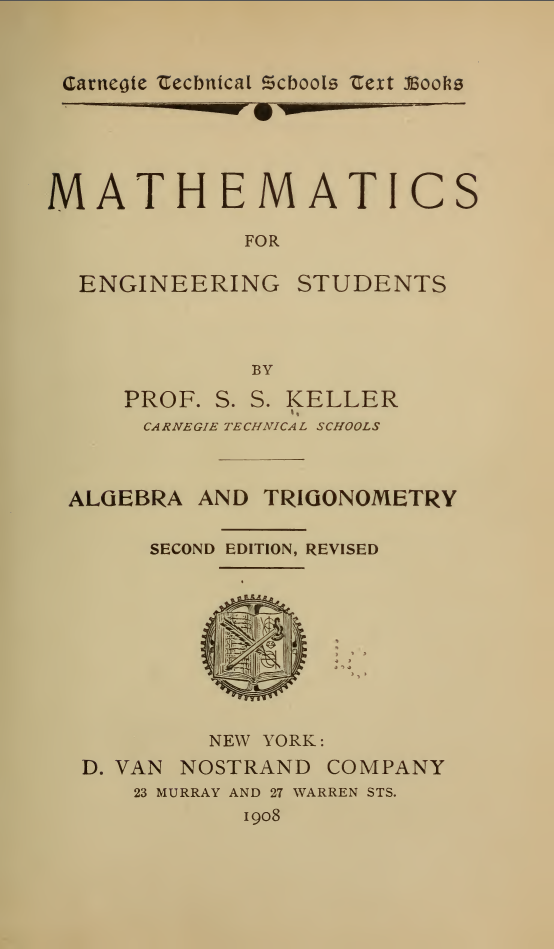- 세상의 모든 계산기 수학, 과학, 공학 이야기 공학 ()
Mathematics For Engineering Students 1908
1908년에 출판된 학생용 교재입니다.
기초적인 내용이 들어 있네요.
전부 보진 않았는데, 초중고에서 배우는 내용이 대부분인 듯 합니다.
https://www.survivorlibrary.com/index.php/Engineering_General
| 2016-11-15 | Mathematics For Engineering Students 1908 | PDF19 mb |

## Table of Contents
### Chapter I: Algebra and Arithmetic
1. **Definitions and Symbols**
Pages 1-3
2. **Addition**
- Addition of Monomials: Page 4
- Addition of Polynomials: Page 5
- Addition of Negative Numbers: Page 7
3. **Subtraction**
- Subtraction of Monomials: Page 5
- Subtraction of Polynomials: Page 6
- Subtraction of Negative Numbers: Page 7
4. **Multiplication and Division**
- Multiplication: Page 9
- Division: Page 10
5. **Exponents**
Page 10
6. **Polynomial Operations**
- Multiplication of a Polynomial by a Monomial: Page 11
- Division of a Polynomial by a Monomial: Page 11
- Multiplication of a Polynomial by a Polynomial: Page 12
- Division of a Polynomial by a Polynomial: Page 12
### Chapter II: Definitions and Types
1. **Definitions and Type Forms**
Pages 16-19
2. **Greatest Common Divisor**
Pages 20-24
3. **Least Common Multiple**
Pages 24-26
4. **Fractions**
Pages 27-29
### Chapter III: Equations
1. **General Concepts**
Pages 30-31
2. **Literal Equations and Uses of Letters**
Page 31
3. **Degree of an Equation**
Page 32
4. **Solving Equations**
- Clearing of Fractions: Page 33
- Transposition: Page 34
- Solution of Linear Equation of One Unknown: Page 34
- Simultaneous Linear Equations: Page 35
- Elimination by Substitution: Page 37
- Elimination by Indeterminate Coefficients: Page 38
- More than Two Unknowns: Page 39
### Chapter IV: Graphics
Pages 47-53
### Chapter V: The Binomial Theorem
- Involution and Evolution: Page 58
- Extraction of Roots: Page 59
- Square Root: Page 60
- Cube Root: Page 61
### Chapter VI: Surds
1. **Introduction to Surds**
Pages 65-66
2. **Simplification and Operations**
- Simplification: Page 67
- Order of a Surd: Page 68
- Reduction of Mixed Surds: Page 69
- Addition and Subtraction: Page 69
- Multiplication and Division: Pages 69-70
- Comparison: Page 70
- Rationalizing Denominators: Page 71
3. **Roots of Quadratic Surds**
- General Method: Page 74
- Another Method: Page 75
4. **Imaginaries**
Pages 77-77
- Multiplication of Imaginaries: Page 77
### Chapter VII: Indeterminate Equations
Pages 80-87
### Chapter VIII: Quadratic Equations
1. **Basics of Quadratics**
- Single Unknown: Page 88
- Kinds of Quadratics: Page 88
2. **Solving Quadratics**
- Roots of a Quadratic: Page 89
- Solution of Incomplete Quadratic: Page 89
- Solution of Complete Quadratic: Page 89
- Geometrical Illustration: Page 90
- Literal and Numerical Equations: Page 90
- Solution by Factoring: Page 91
- Solution by Substitution: Page 93
- Equations Involving Radicals: Page 93
- Equations of Higher Degree: Page 94
- Solution by Factoring: Page 95
- Character of Roots: Page 96
3. **Maxima and Minima**
Page 102
4. **Equations of Two or More Unknowns**
- Degree Higher than the First: Page 105
### Chapter IX: Logarithms
1. **Introduction to Logarithms**
Page 114
2. **Logarithms of Decimals**
Page 117
3. **Cologarithms**
Page 119
4. **Finding a Number from Its Logarithm**
Page 120
### Chapter X: Inequalities
Pages 125-127
### Chapter XI: Progressions
1. **Arithmetical Series**
Page 136
2. **Arithmetical Mean**
Page 138
3. **Geometrical Progression**
- Value of Any Term: Page 141
- Geometrical Mean: Page 142
4. **Infinite Series**
Page 143
5. **Harmonical Progression**
Page 145
### Chapter XII: Interest and Annuities
1. **Interest Definitions**
Page 147
2. **Simple Interest**
Page 147
3. **Compound Interest**
Page 147
4. **Annuities**
Page 148
### Plane Trigonometry
#### Part I: Basic Trigonometry
1. **Relation between Angle and Line**
Page 155
2. **Trigonometric Ratios**
Page 156
3. **Functions**
- Functions of 45°: Page 161
- Functions of 60°: Page 162
4. **Identities**
Page 168
5. **Trigonometric Equations**
Page 169
#### Part II: Solution of Triangles
1. **The Right Triangle**
Page 172
2. **The Isosceles Triangle**
Page 174
3. **Regular Polygons**
Page 175
4. **Areas**
Page 177
#### Part III: Further Relations
1. **Functions of Angles**
- Expressing Functions in Terms of First Quadrant Angles: Page 193
- Sum and Difference of Functions: Page 200
- Functions of Half an Angle: Page 209
2. **Inverse Trigonometric Functions**
Page 213
#### Part IV: Solution of Oblique Triangles
Page 215
#### Part V: Spherical Trigonometry
1. **Right Spherical Triangles**
Page 225
2. **The Isosceles Triangle**
Page 230
3. **The Oblique Triangle**
Page 231
#### Part VI: Applications
1. **Area of a Spherical Triangle**
Page 244


세상의모든계산기 님의 최근 댓글
TI-nspire 입력 방법 solve({x+a+b=5,x)|a=1 and b=2 2025 12.01 질문하실 때는 항상 계산기 모델명을 정확하게 적으셔야 합니다. 2025 12.01 참고 - [공학용 계산기] 로그의 입력 (log, ln) (feat. 밑 입력이 안되는 계산기는?) https://allcalc.org/14995 2025 11.14 HP-39gII 에 ExistOS 설치하기 https://allcalc.org/38526 2025 11.07 1. 왜 검은색이 아닌 다른 색으로 보일까? (제공된 LUT 필터) 제가 제공해 드린 magenta_lens.cube LUT 필터는 540~560nm(녹색-노란색) 파장대의 색상을 '완전히 제거(검은색으로 만듦)'하는 대신, '다른 색상으로 왜곡/변환'하도록 설계되었습니다. * 원리: LUT(Look-Up Table)는 특정 입력 색상(Input RGB)을 미리 정해진 다른 출력 색상(Output RGB)으로 매핑하는 테이블입니다. 이 LUT는 540~560nm에 해당하는 RGB 값들이 들어오면, 검은색(0, 0, 0)이 아닌, 매우 어둡거나 채도가 낮은 특정 색(예: 어두운 올리브색, 갈색 등)으로 변환하라고 지시합니다. * 의도: * 현실적인 물리 필터 시뮬레이션: 실제 고가의 색약 보정 안경도 특정 파장을 100% 완벽하게 차단하지는 못합니다. 빛의 일부를 흡수하고 일부는 통과시키거나 변환하는데, 이 LUT는 그러한 현실 세계의 필터 효과를 더 비슷하게 흉내 냈을 수 있습니다. * 시각적 정보 유지: 특정 색을 완전히 검게 만들면 그 부분의 형태나 질감 정보가 완전히 사라집니다. 하지만 다른 어두운 색으로 대체하면, 색상 정보는 왜곡되더라도 밝기나 형태 정보는 어느 정도 유지되어 전체적인 이미지가 덜 어색하게 보일 수 있습니다. 결론적으로, 스펙트럼 그림에서 해당 대역의 색이 갑자기 '다른 색으로 툭 바뀌는' 현상은, LUT 필터가 "이 파장대의 색은 앞으로 이 색으로 표시해!"라고 강제적으로 지시한 결과이며, 이것이 바로 이 필터가 작동하는 방식 그 자체입니다. 2. 왜 'Color Vision Helper' 앱은 검은색으로 보일까? 비교하신 'Color Vision Helper' 앱은 노치 필터의 원리를 더 이상적(Ideal)이고 교과서적으로 구현했을 가능성이 높습니다. * 원리: "L-콘과 M-콘의 신호가 겹치는 540~560nm 파장의 빛은 '완전히 차단'되어야 한다"는 개념에 매우 충실한 방식입니다. * 구현: 따라서 해당 파장에 해당하는 색상 정보가 들어오면, 어떠한 타협도 없이 그냥 '검은색(RGB 0, 0, 0)'으로 처리해 버립니다. 이는 "이 파장의 빛은 존재하지 않는 것으로 처리하겠다"는 가장 강력하고 직접적인 표현입니다. 2025 11.06